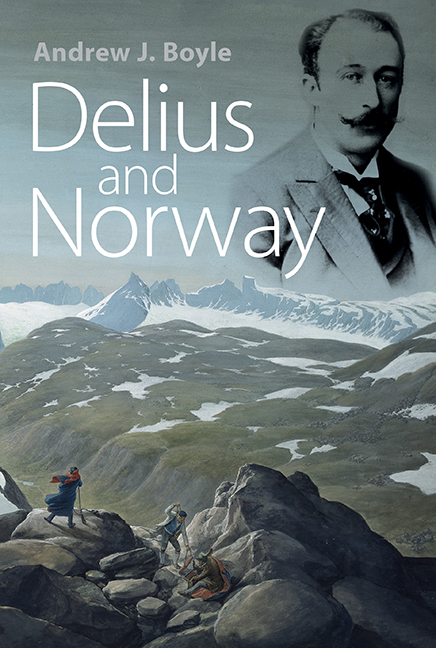Book contents
- Frontmatter
- Dedication
- Contents
- List of illustrations and tables
- Preface
- Abbreviations
- Selected glossary of landscape terms used in place names
- 1 Norway's awakening
- 2 1862–1888: Bradford, Florida and Leipzig
- 3 1888–1889: With Grieg on the heights
- 4 1890–1891: ‘C'est de la Norderie’
- 5 1892–1895: Norway lost
- 6 1896: Norway regained
- 7 1897: Front page news
- 8 1898–1902: Unshakeable self-belief
- 9 1903–1907: Breakthrough in Germany and England
- 10 1908–1912: Changes of direction
- 11 1912–1918: High hills, dark forests
- 12 1919–1934: Myth and reality in Lesjaskog
- Appendix I List of visits to Norway
- Appendix II Works with Norwegian and Danish texts and associations
- Selected bibliography and archival sources
- Index
6 - 1896: Norway regained
Published online by Cambridge University Press: 30 August 2017
- Frontmatter
- Dedication
- Contents
- List of illustrations and tables
- Preface
- Abbreviations
- Selected glossary of landscape terms used in place names
- 1 Norway's awakening
- 2 1862–1888: Bradford, Florida and Leipzig
- 3 1888–1889: With Grieg on the heights
- 4 1890–1891: ‘C'est de la Norderie’
- 5 1892–1895: Norway lost
- 6 1896: Norway regained
- 7 1897: Front page news
- 8 1898–1902: Unshakeable self-belief
- 9 1903–1907: Breakthrough in Germany and England
- 10 1908–1912: Changes of direction
- 11 1912–1918: High hills, dark forests
- 12 1919–1934: Myth and reality in Lesjaskog
- Appendix I List of visits to Norway
- Appendix II Works with Norwegian and Danish texts and associations
- Selected bibliography and archival sources
- Index
Summary
‘I am leading a life quite Adam like’
Letter from Delius to Jelka Rosen, 15 June 1896I first met Delius in January 1896 in Paris at the house of a Swedish sculptress, Mme Benedix-Bruce; her husband was a Canadian painter. Knowing how much I loved the songs of Grieg which I sang so often, she always said: ‘You must know a young Englishman, a friend of ours. He also loves Grieg and composes music himself ’ […] I did not wish to see this young man she always spoke of. But once when I dined there with my mother who was living with me in Paris, he was there too.
Helene Rosen was born in 1868. Known to all as Jelka, she was a painter from a Schleswig-Holstein family with distinguished figures in music and diplomacy. After this dinner, the hostess implored Jelka to sing for the company:
I sang the ‘Swan’ and ‘Solveig's Song’ of Grieg – with a naiveté I have often marvelled at later on, for I had but a small soprano voice and had only had just a few singing and breathing lessons. […] Anyhow Delius seemed to like my singing, for he told me he would come to my studio and bring me a book of his own songs.
Delius brought his Seven Songs from the Norwegian and played for her one of the songs that Grieg had also set, probably ‘Twilight Fancies’, and informed Jelka that he considered his version the superior one. If it was through Grieg's music they had made their introductions, it was an author who bound them together: ‘At that time I was full of enthusiasm for Nietzsche's Zarathustra’, she related, ‘and I was greatly surprised when this young Englishman said he knew and loved Zarathustra’.
Jelka frequently entertained Delius at her studio and as winter turned to spring in Paris she enjoyed ‘a happy, wonderful time’. They would sometimes take the train out from the city and go for long walks in the countryside. After submitting her latest canvas to the spring Salon des Indépendants, Jelka indulged herself with a few days of holiday in the village of Grez-sur-Loing, near Fontainebleau. Delius arranged to be visiting at the same time the neighbouring village of Bourron, where his friend Charles F.
- Type
- Chapter
- Information
- Delius and Norway , pp. 116 - 132Publisher: Boydell & BrewerPrint publication year: 2017

